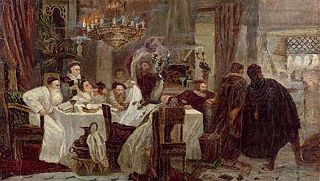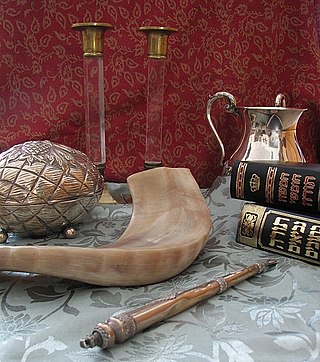Related Research Articles

The Book of Esther, also known in Hebrew as "the Scroll", is a book in the third section of the Hebrew Bible. It is one of the Five Scrolls in the Hebrew Bible and later became part of the Christian Old Testament. The book relates the story of a Jewish woman in Persia, born as Hadassah but known as Esther, who becomes queen of Persia and thwarts a genocide of her people.

Esther is the eponymous heroine of the Book of Esther. The story the book tells is as follows: Ahasuerus, the king of the Persian Achaemenid Empire, falls in love with the beautiful Jewish woman Esther and makes her his Queen. His grand vizier, Haman, is offended by Esther's cousin and guardian, Mordecai, who refuses to prostrate himself before Haman. Haman plots to have all the Jews in Persia killed, and convinces Ahasuerus to permit him to do so. However, Esther foils the plan by revealing Haman's eradication plans to Ahasuerus, who then has Haman executed and grants permission to the Jews to kill their enemies.

Adar is the sixth month of the civil year and the twelfth month of the religious year on the Hebrew calendar, roughly corresponding to the month of March in the Gregorian calendar. It is a month of 29 days.

Mordecai is one of the main personalities in the Book of Esther in the Hebrew Bible. He is described in Tanna Devei Eliyahu as being the son of Jair, of the tribe of Benjamin and member of the Sanhedrin. Mordecai was also the cousin and guardian of Esther, who became queen of Persia under the reign of Ahasuerus. Mordecai's loyalty and bravery are highlighted in the story as he helps Esther foil the plot of Haman, the king's Vizier, to exterminate the Jewish people.

Marranos is one of the terms used in relation to Spanish and Portuguese Jews who converted or were forced by the Spanish and Portuguese crowns to convert to Christianity during the fifteenth and sixteenth centuries, but continued to practice Judaism in secrecy or were suspected of it, referred to as Crypto-Jews. "Crypto-Jew" is the term increasingly preferred in scholarly works, instead of Marrano.

Purim is a Jewish holiday that commemorates the saving of the Jewish people from annihilation at the hands of an official of the Achaemenid Empire named Haman, as it is recounted in the Book of Esther.

A converso, "convert", was a Jew who converted to Catholicism in Spain or Portugal, particularly during the 14th and 15th centuries, or one of their descendants.

Crypto-Judaism is the secret adherence to Judaism while publicly professing to be of another faith; practitioners are referred to as "crypto-Jews".

Tevet is the fourth month of the civil year and the tenth month of the ecclesiastical year on the Hebrew calendar. It follows Kislev and precedes Shevat. It is a month of 29 days. Tevet usually occurs in December–January on the Gregorian calendar. In the Babylonian calendar its name was Araḫ Ṭebētum, the "muddy month".

Haman is the main antagonist in the Book of Esther, who according to the Hebrew Bible was an official in the court of the Persian empire under King Ahasuerus, commonly identified as Xerxes I but traditionally equated with Artaxerxes I or Artaxerxes II. As his epithet Agagite indicates, Haman was a descendant of Agag, the king of the Amalekites. Some commentators interpret this descent to be symbolic, due to his similar personality.
New Christian was a socio-religious designation and legal distinction in the Spanish Empire and the Portuguese Empire. The term was used from the 15th century onwards primarily to describe the descendants of the Sephardic Jews and Moors baptised into the Catholic Church following the Alhambra Decree. The Alhambra Decree of 1492, also known as the Edict of Expulsion, was an anti-Jewish law made by the Catholic Monarchs upon the Reconquista of the Iberian Peninsula. It required Jews to convert to Catholic Christianity or be expelled from Spain. Most of the history of the "New Christians" refers to the Jewish converts, who were generally known as Conversos while the Muslim converts were known as Moriscos.

The history of the Jewish community in Belmonte, Portugal, dates back to the 13th century; the community was composed of Spanish and Portuguese Jews who kept their faith through crypto-Judaism.
Spanish and Portuguese Jews, also called Western Sephardim, Iberian Jews, or Peninsular Jews, are a distinctive sub-group of Sephardic Jews who are largely descended from Jews who lived as New Christians in the Iberian Peninsula during the few centuries following the forced expulsion of unconverted Jews from Spain in 1492 and from Portugal in 1497. They should therefore be distinguished both from the descendants of those expelled in 1492 and from the present-day Jewish communities of Spain and Portugal.
The Fast of Esther is a fast on Purim eve commemorating two communal fasts undertaken by the Persian Jewish community of Shushan in the Book of Esther, for the purpose of praying for salvation from annihilation by an evil decree which had been instigated by the royal vizier, an anti-jewish enemy, of the Amalekite nation.

The painting Ahasveros and Haman at the Feast of Esther is one of the few works of Rembrandt van Rijn whose complete provenance is known. The origin of the painting can be traced back to 1662, two years after its completion.
There are only three figures in the picture and the banquet is suggested sketchily. Esther lowers her arms apprehensively as she finishes her speech, the king's lips are pursed in anger, and Haman's pose reveals a sense of doom. The distance between the king and his vizier seems enormous, while the king and queen form a united pair.

Esther, also known as The Bible: Esther, is a 1999 American-Italian-German television film based on the Book of Esther, directed by Raffaele Mertes and starring Louise Lombard as Queen Esther, F. Murray Abraham as Mordechai, Jürgen Prochnow as Haman, Thomas Kretschmann as King Achashverosh and Ornella Muti as Vashti.
Judaism's doctrines and texts have sometimes been associated with violence or anti-violence. Laws requiring the eradication of evil, sometimes using violent means, exist in the Jewish tradition. However, Judaism also contains peaceful texts and doctrines. There is often a juxtaposition of Judaic law and theology to violence and nonviolence by groups and individuals. Attitudes and laws towards both peace and violence exist within the Jewish tradition. Throughout history, Judaism's religious texts or precepts have been used to promote as well as oppose violence.

Second Purim, also called Purim Katan, is a celebratory day uniquely observed by a Jewish community or individual family to commemorate the anniversary of its deliverance from destruction, catastrophe, or an antisemitic ruler or threat. Similar to the observance of the Jewish holiday of Purim, Second Purims were typically commemorated with the reading of The Megillah about the events that led to the salvation, specially-composed prayers, a festive meal, and the giving of charity. In some cases, a fast day was held the day before. Second Purims were established by hundreds of communities in the Jewish diaspora and in the Land of Israel under foreign rule. Most Second Purims are no longer observed.

Esther 9 is the ninth chapter of the Book of Esther in the Hebrew Bible or the Old Testament of the Christian Bible, The author of the book is unknown and modern scholars have established that the final stage of the Hebrew text would have been formed by the second century BCE. Chapters 9 to 10 contain the resolution of the stories in the book. This chapter records the events on the thirteenth and fourteenth of Adar and the institution of the Purim festival after the Jews overcome their enemies.
Rosh Chodesh L'Banot, also known as Chag HaBanot, and in Arabic as Eid al-Banat, is a holiday celebrated by some Jewish communities in the Middle East on Rosh Chodesh of the Jewish month of Tevet, during the Jewish holiday of Chanukah. The Jewish community where the holiday was most preserved is in Tunisia. But there is also evidence that it was also celebrated in Jewish communities in Libya, Algeria, Kushta, Istanbul, Morocco and Thessaloniki.
References
- ↑ Queen Esther: Patron saint of crypto-Jews
- ↑ “Women, Ritual, and Secrecy: The Creation of the Crypto-Jewish Culture,” Janet Liebman Jacobs
- ↑ "The Fast of Esther in the Lore of the Marranos" - Prof. Moshe Orfali; Dept. of Jewish History
- ↑ The Book of Esther in Modern Research